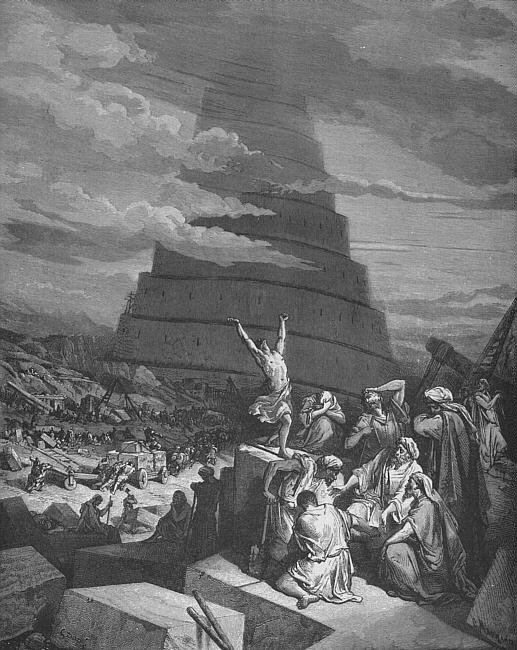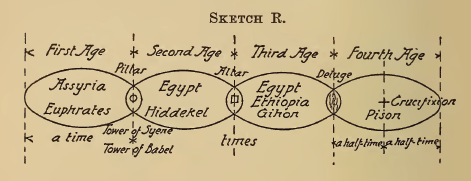Tower of Babel (Syene).
The pillar to the LORD.
Built by the Euphratic Race 23,017 B.C. to 21,424 B.C.
Genesis xi. 1-9
1 And the whole earth was of one language, and of one speech.
2 And it came to pass, as they journeyed from the east, that they found a plain in the land of Shinar; and they dwelt there.
3 And they said one to another, Go to, let us make brick, and burn them thoroughly. And they had brick for stone, and slime had they for morter.
4 And they said, Go to, let us build us a city and a tower, whose top may reach unto heaven; and let us make us a name, lest we be scattered abroad upon the face of the whole earth.
5 And the Lord came down to see the city and the tower, which the children of men builded.
6 And the Lord said, Behold, the people is one, and they have all one language; and this they begin to do: and now nothing will be restrained from them, which they have imagined to do.
7 Go to, let us go down, and there confound their language, that they may not understand one another's speech.
8 So the Lord scattered them abroad from thence upon the face of all the earth: and they left off to build the city.
9 Therefore is the name of it called Babel; because the Lord did there confound the language of all the earth: and from thence did the Lord scatter them abroad upon the face of all the earth.
From all that has gone before it seems that this piece of history must pertain to the First Age of Man, and that the building of this city and tower was the conception and work of the Euphratic or White race; for the time when the people was one, and the whole earth was of one language and one speech, was that of the First age. The text states, "As they journeyed from the east." What does the east represent? The east (see Diagram 1) represents the Second Age of Man, or the Hiddekelic age. Why should this people journey from the east? It is that they may be free from the new-born Hiddekelic race. Why should they desire to get away from the Hiddekelic race? It is that they may not be scattered abroad by them; for by the vision of St. John (see Rev. vi. 4) the Second race was to take peace from the earth, and that they should kill one another. The Hiddekelic race is represented as being armed with a sword, while the First race is armed only with a bow. Why should they seek to build a city and tower of such magnitude?
It undoubtedly was for the purpose of impressing their natural enemies with an idea of their strength and greatness, or, as implied by the text, to make them a name, so as, if possible, to check the aggressive movements of the Hiddekels, lest they be scattered abroad. However, their device was brought to naught; for the Lord sent confusion of tongue among them, which was fulfilled as the Hiddekels, with their diverse speech, advanced and overwhelmed them. That war shall exist between these two races is further indicated in Isa. iii. 25; Isa. xiii. 15, 16; Rev. vi. 4. From the text it is evident that the Euphratic race was as corrupt as, later, were the Gihons, or sons of God, who were swept away by the Deluge of Noah. The overlap of the two races — viz., the Euphratic and Hiddekelic — is evidence that the First age has nearly fulfilled its allotted days; for by the allegories (see Diagrams 1-11) the races are consecutive.
The Law governing the transmission of iniquity, however, requires an escaping remnant; wherefore the Second race was brought forth before the First was destroyed, or, as may be inferred from the text, before they were scattered abroad upon the face of all the earth. The fulfilment of the divine command given man to increase and multiply would naturally people the earth, and they, in consequence, would dwell in comparative peace; but the text indicates that the alarm of those building the tower was due to some force altogether outside of themselves.
As, therefore, the whole earth was included in the alarm, the probabilities are that it arose from the advent and aggression of the newly-created Hiddekelic race, from which it follows that the Tower of Babel was constructed by the First or Euphratic race somewhere between the year 23,017 B.C. and the year 21,414 B.C. It may be that vestiges of this structure remain unto this day, owing to the durability of the brick used, which, by the text, were to be thoroughly burned ; a condition conveying the idea that they should last for ages. This Tower, or Pillar, seems to be the one called for in Isa. xix. 19, 20, as follows: "In that day shall there be an altar to the Lord in the midst of the land of Egypt, and a pillar at the border thereof to the Lord." And it shall be for a sign and for a witness unto the Lord of hosts in the land of Egypt: for they shall cry unto the Lord because of the oppressors."
By reference to Diagrams 1 and 16, it will be seen that Assyria is emblematic of
the First age, and Egypt is emblematic of both the Second and Third ages of Man,
or "the times;'' while the Pisonic or Fourth age is known from its own burden
or mission; therefore the positions of both altar and pillar are readily made
manifest by Diagram 12.
Thus the Pillar, or Tower of Babel, stands at the border of Egypt, or in the overlap of the First and Second ages, a sign and witness that the oppressor is at hand and that the people of the Euphratic race fear for their lives. By the diagram, however, it will be seen that their fears were realized, and that they were swept away from the face of the earth, with the exception of the escaping remnant. The command for the destruction of this race is given in Ezek. ix. 5, 6: "Go ye after him through the city, and smite: let not your eye spare, neither have ye pity: "Slay utterly old and young, both maids, and little children, and women: but come not near any man upon whom is the mark.'' The Tower of Babel was built during the overlap of the Euphratic and Hiddekelic races; but the Hiddekels becoming as corrupt as the Euphratics, they, in turn, were swept away.
Is it Babel or Syene?
Syene is a city on the southern frontiers of Egypt, towards Ethiopia, between Thebes and the cataracts of the Nile, and now called Assouan. Pliny says it stands in a peninsula on the eastern shore of the Nile; that is was a mile in circumference, and had a Rome garrison. "From Migdol," the tower, "unto Syene," denotes the whole length of Egypt from north to south, (see Ezek. xxix. 10; Ezek. xxx. 6). Few remains of the ancient city are now extant. In its vicinity are quarries of the Egyptian granite called Syenite, which furnished the material for numerous obelisks and colossal statues. The Tower of Syene indicates in all probability the same magnitude as the Tower of Babel; the Tower of Babel was built (see Gen. xi. 1-9) during the overlap of the Euphratic and Hiddekelic races; while the river Gihon (see Gen. ii. 13) compasses the whole land of Ethiopia; hence the land of Egypt from the Tower of Syene, or of Babel, unto the extreme boder of Ethiopia, as shadow, would include both the Hiddekelic and the Gihonic ages.
//∞\\


